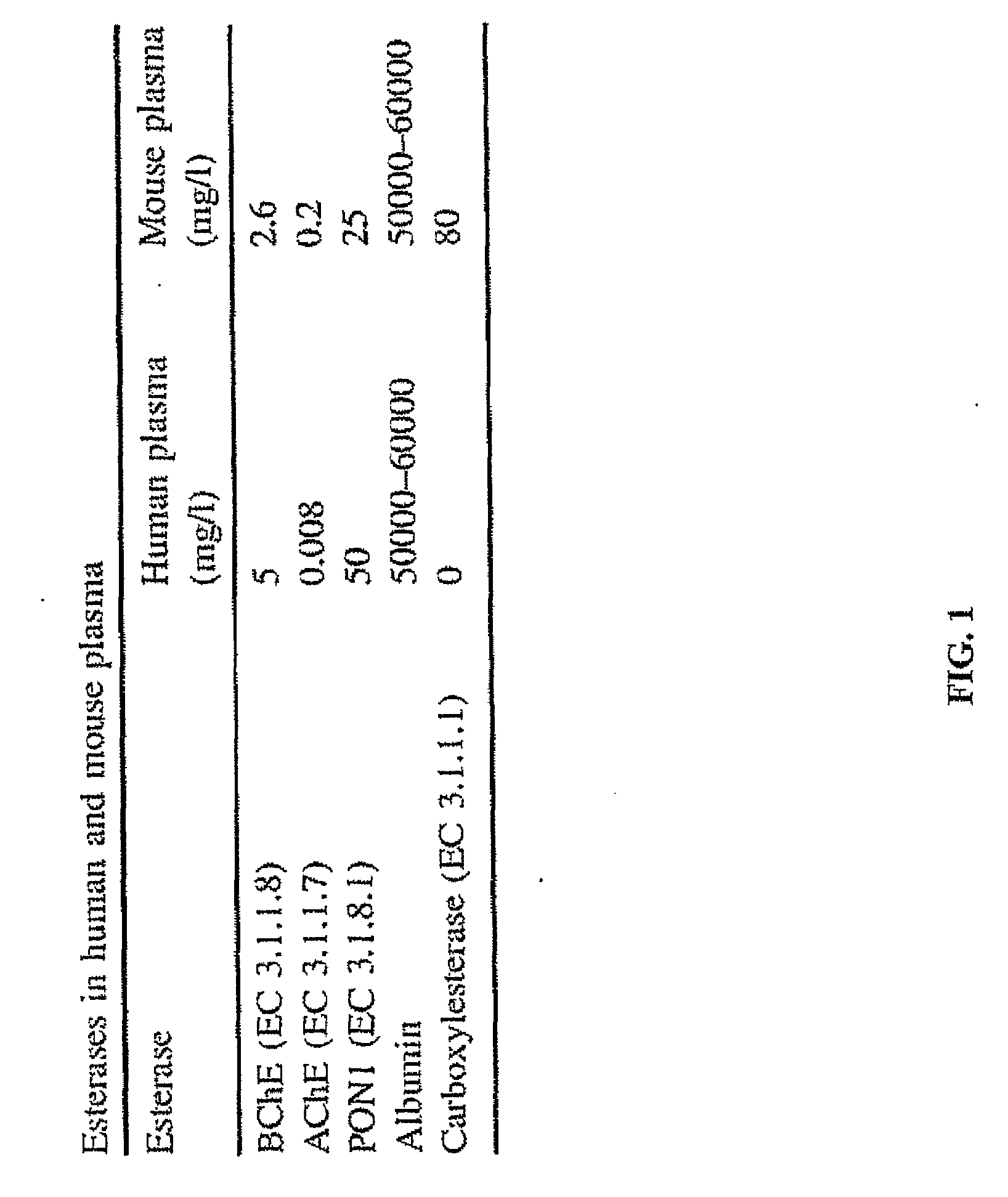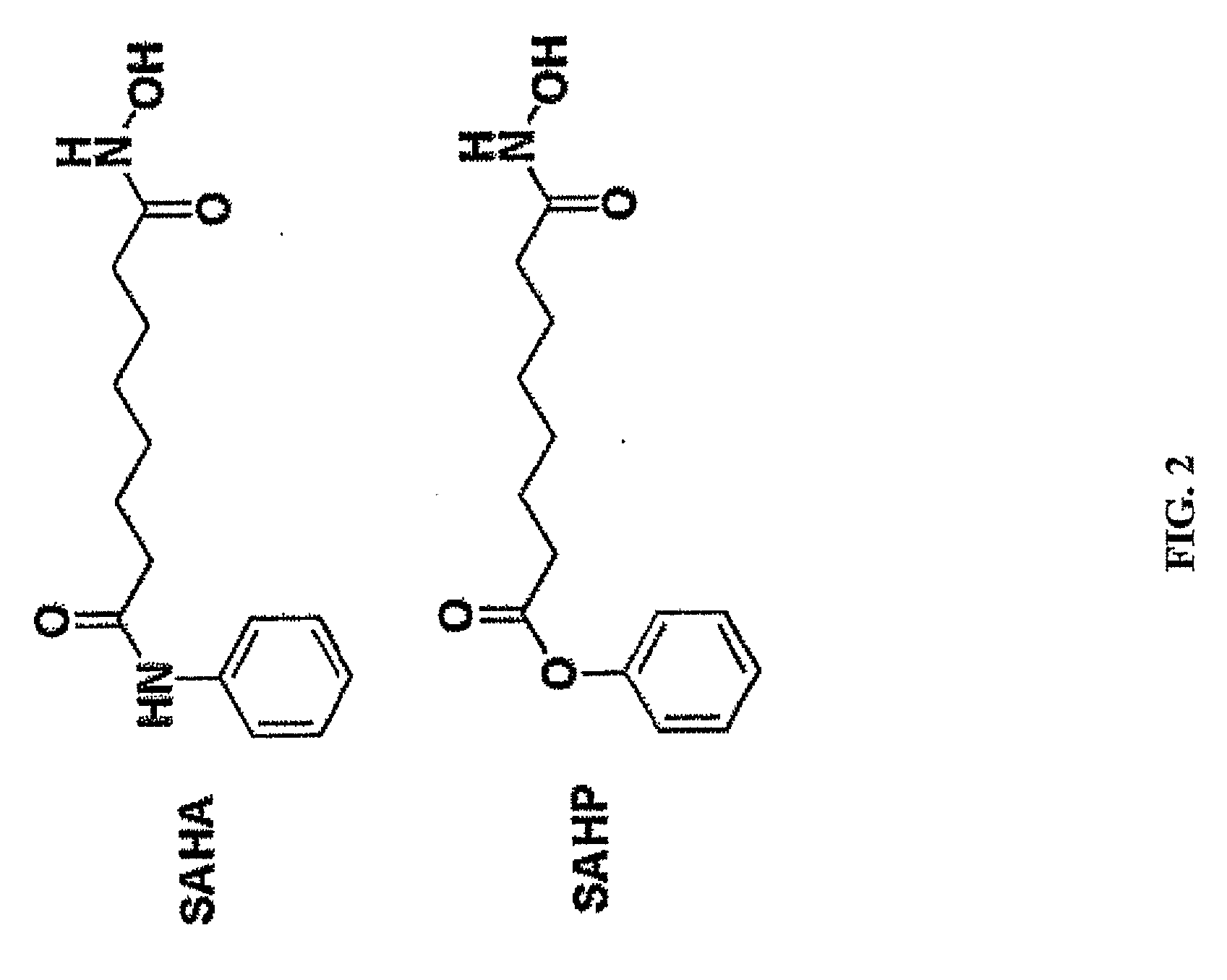Histone deacetylase inhibitors
a technology of histone deacetylase and inhibitors, which is applied in the direction of biocide, heterocyclic compound active ingredients, drug compositions, etc., can solve the problem of esterase cleavage and easy esterase linkage, and achieve the effect of reducing systemic toxicity
- Summary
- Abstract
- Description
- Claims
- Application Information
AI Technical Summary
Benefits of technology
Problems solved by technology
Method used
Image
Examples
example 1
Synthesis of SAB for Use as HDAC Inhibitors
[0265]
[0266]Described below is the synthesis of a SAHP, an ester-containing analog of SAHA (as shown in FIG. 12).
[0267]3.86 g (24.2 mmol) O-benzylhydroxylamine hydrochloride and 13 mL (75 mmol) diisopropylethylamine were dissolved in 100 mL methylene chloride and cooled to 0° C. 5.00 g (24.2 mmol) methyl 8-chloro-8-oxooctanoate were dissolved in 10 mL methylene chloride and slowly added to the reaction mixture. The reaction mixture was stirred for 1 h at 0° C. and warmed to room temperature. After stirring for additional 12 h, 300 mL 0.5N HCl were added. The organic layer was separated and washed with brine and sat. bicarb. After drying over sodium sulfate, the organic solvent was removed under reduced pressure and the crude product was purified on silica (methylene chloride / methanol 12:1, r=0.7) to yield the desired compound 1 as white solid (6.3 g, 89%).
[0268]6.3 g (21.5 mmol) methyl ester 1 were dissolved in 200 mL methanol, followed by ...
example 2
Biological Assay Procedures
[0271]Cell culture and Transfections. TAg-Jurkat cells were transfected by electroporation with 5 μg of FLAG-epitope-tagged pBJ5 constructs for expression of recombinant proteins. Cells were harvested 48 h posttransfection.
[0272]HDAC assays. [3H]Acetate-incorporated histones were isolated from butyrate-treated HeLa cells by hydroxyapatite chromatography (as described in Tong, et al Nature 1997, 395, 917-921.) Immunoprecipitates were incubated with 1.4 μg (10,000 dpm) histones for 3 h at 37° C. HDAC activity was determined by scintillation counting of the ethyl acetate-soluble [3H]acetic acid (as described in Taunton, et al., Science 1996, 272, 408-411). Compounds were added in DMSO such that final assay concentrations were 1% DMSO. IC50s were calculated using Prism 3.0 software. Curve fitting was done without constraints using the program's Sigmoidal-Dose Response parameters. All data points were acquired in duplicate and IC50s are calculated from the comp...
example 3
In Vivo Activity
[0273]Although a variety of methods can be utilized, one exemplary method by which the in vivo activity of the inventive compounds is determined is by subcutaneously transplanting a desired tumor mass in mice. Drug treatment is then initiated when tumor mass reaches approximately 100 mm3 after transplantation of the tumor mass. A suitable composition, as described in more detail above, is then administered to the mice, preferably in saline and also preferably administered once a day at doses of 5, 10 and 25 mg / kg, although it will be appreciated that other doses can also be administered. Body weight and tumor size are then measured daily and changes in percent ratio to initial values are plotted. In cases where the transplanted tumor ulcerates, the weight loss exceeds 25-30% of control weight loss, the tumor weight reaches 10% of the body weight of the cancer-bearing mouse, or the cancer-bearing mouse is dying, the animal is sacrificed in accordance with guidelines f...
PUM
| Property | Measurement | Unit |
|---|---|---|
| Disorder | aaaaa | aaaaa |
Abstract
Description
Claims
Application Information
 Login to View More
Login to View More - R&D
- Intellectual Property
- Life Sciences
- Materials
- Tech Scout
- Unparalleled Data Quality
- Higher Quality Content
- 60% Fewer Hallucinations
Browse by: Latest US Patents, China's latest patents, Technical Efficacy Thesaurus, Application Domain, Technology Topic, Popular Technical Reports.
© 2025 PatSnap. All rights reserved.Legal|Privacy policy|Modern Slavery Act Transparency Statement|Sitemap|About US| Contact US: help@patsnap.com



